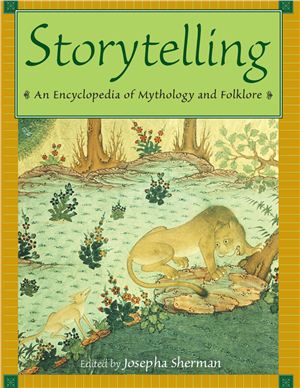Editor - Josepha Sherman, M.E. Sharpe Reference, 2008, 904 pp.
This set does an effective job of summarizing the major elements of a complex topic: storytelling. Coverage spans oral tradition from its roots, the earliest recorded stories and creation myths, and follows the development of intertwined and contrasting themes, genres, and motifs throughout history, culminating with mode-day urban legends and superheroes. The set is divided into three main sections. The first consists of alphabetically arranged entries on people, places, creatures, characters, cultures, religions, societal norms, adaptations, interpretations, and styles and devices. Entries have been written by various contributors (some are signed) and range from a paragraph to several pages. Occasional black-and-white illustrations and reproductions are scattered throughout. Sources (usually print) are provided for each article, and many articles include see also references. The second part offers retellings of traditional stories. The 49 selections represent an inteational array of standards and offer a sampling of various subgenres. Care has been taken to preserve original nuances, conventions, and cadences. Samples include a folktale from the Talmud, a changeling tale from Wales, a shape-shifting story from Germany, a parable from the Jataka, a collection of Buddhist moral tales, a riddle tale, a fool tale, hero myths, indigenous legends, and selections from epics. The third part details storytelling resources: a worldwide list of college and university courses in storytelling studies, including contact information; a directory of inteational storytelling festivals; bibliographies of print materials about storytelling, collections of folktales, and tale type and motif indexes; and a detailed index. These support materials, when combined with the background information provided in the introduction (history, rationale, definitions, materials collection, storytelling techniques, and various applications), help create a comprehensive overview. This well-written and accessible set is recommended for large public and academic collections that support teacher-education programs or that cater to storytellers. ISBN-10: 0765680475, ISBN-13: 978-0765680471
This set does an effective job of summarizing the major elements of a complex topic: storytelling. Coverage spans oral tradition from its roots, the earliest recorded stories and creation myths, and follows the development of intertwined and contrasting themes, genres, and motifs throughout history, culminating with mode-day urban legends and superheroes. The set is divided into three main sections. The first consists of alphabetically arranged entries on people, places, creatures, characters, cultures, religions, societal norms, adaptations, interpretations, and styles and devices. Entries have been written by various contributors (some are signed) and range from a paragraph to several pages. Occasional black-and-white illustrations and reproductions are scattered throughout. Sources (usually print) are provided for each article, and many articles include see also references. The second part offers retellings of traditional stories. The 49 selections represent an inteational array of standards and offer a sampling of various subgenres. Care has been taken to preserve original nuances, conventions, and cadences. Samples include a folktale from the Talmud, a changeling tale from Wales, a shape-shifting story from Germany, a parable from the Jataka, a collection of Buddhist moral tales, a riddle tale, a fool tale, hero myths, indigenous legends, and selections from epics. The third part details storytelling resources: a worldwide list of college and university courses in storytelling studies, including contact information; a directory of inteational storytelling festivals; bibliographies of print materials about storytelling, collections of folktales, and tale type and motif indexes; and a detailed index. These support materials, when combined with the background information provided in the introduction (history, rationale, definitions, materials collection, storytelling techniques, and various applications), help create a comprehensive overview. This well-written and accessible set is recommended for large public and academic collections that support teacher-education programs or that cater to storytellers. ISBN-10: 0765680475, ISBN-13: 978-0765680471

